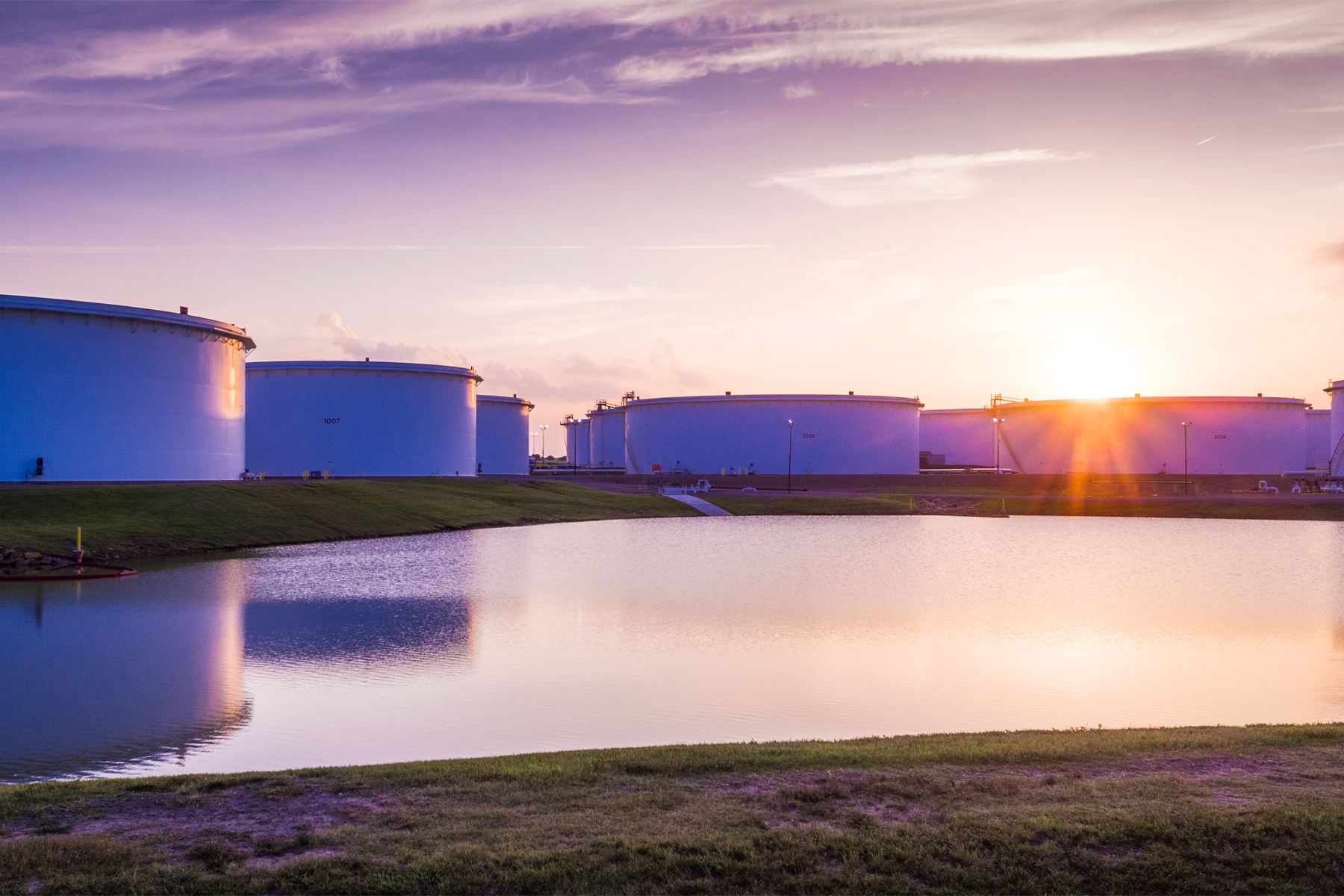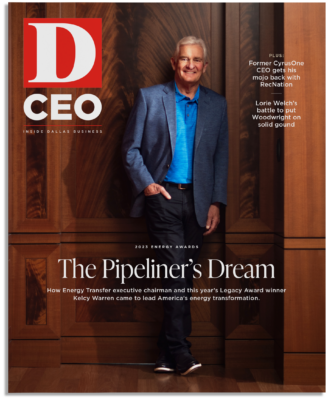When the Shale gas boom in North Texas’ Barnett Shale began losing steam in the wake of the 2008-–09 downturn, Kelcy Warren was worried. After all, his Energy Transfer Partners was heavily dependent on natural gas as the country’s largest transporter of the fuel. With prices plummeting from $8 to $2 per million cubic feet, reinvention was life. So, he and his executive team quietly began a transformative series of acquisitions.
The March 2011 purchase of the Louis Dreyfus assets gave Energy Transfer a foothold into the natural gas liquids segment. To land the $2 billion deal, with a miniscule and imperative window of opportunity, Warren called an emergency board meeting on a Friday night to pitch and approve the transaction with lightning speed, then announce at the market’s soonest opening.
This is Warren’s style—bold, agile, and inventive. He seizes opportunities when others hesitate. He frequently commends his “brilliant and hard-working” management team and others around him, noting their lockstep movements to help grow the company. On the day of our initial interview, 17 people had been in an early morning casual roundtable in his office; they like to communicate, tell stories, and, of course, generate business ideas.
These days, Energy Transfer operates nearly 125,000 miles of pipeline that transports roughly one-third of the country’s natural gas and crude oil—almost 5 percent of global oil supply. “When we began this whole journey,” Warren says, “everything did not make sense until it did.” He refers to the complex juxtaposition of an infrastructure asset map that expanded and morphed to bring hydrocarbons—gifts of geology—from America’s abundant fields. Energy Transfer has processed, piped, and then handed off supply at Gulf Coast ports, the East Coast, North Dakota’s Bakken and, of course, the Permian and Cushing. “We’ve done a good job of always asking, ‘What is the best purpose of that pipe?’ versus moving resources in other modes of transportation,” he says. His simple approach has yielded rich rewards to America’s economy—and Energy Transfer shareholders. For these reasons and more, Warren is being recognized by D CEO with the top honor in its 2023 Energy Awards program.

The U.S. is now the globe’s top producer of natural gas and crude oil. That happened as a result of shale oil and gas developments, driven by the creativity, sweat, and grit of drillers—and some many hundreds of billions of capital. “The brightest people in the whole industry are the explorers, the risk-takers, and wildcatters,” Warren says. He paraphrases the words of shale godfather George Mitchell: “People think we were innovators. I was drilling the shale formation we thought could work, and finally I realized if I cut back on sand that I could save money and maybe stay in the game.”
“That was brilliant,” Warren says, “to do what they now call slickwater fracs, which Mitchell relayed with such humility. I love that with anyone—that attitude of, ‘I kinda stumbled on it.’ That’s what happens in this industry. You try and fail, and learn more from failures than successes.”
Aside from the sheer volumes of oil and gas that started flowing in shale’s ascent—from North Dakota’s Bakken to Texas’ Permian and Eagle Ford plus Appalachia— America’s hydrocarbon plumbing was ass-backwards. Someone needed to create and convert the country’s pipes and process these new hydrocarbon streams.
The U.S. had been importing natural gas via Gulf Coast LNG import terminals. (Energy Transfer bought one, and re-engineered it into an export terminal, called Lake Charles.) Starting in earnest in 2016, LNG terminals are now moving large volumes of America’s natural gas to Asia and helping Europe with its Russia problem. The U.S. imports from oil club OPEC across 50 years reached a peak of 6 million barrels per day (bd) in 2008, and now stand at just over a million bd. We import roughly 8.5 million bd as of May, much of it from Canada.
To help make this happen, Energy Transfer essentially had to connect America’s burgeoning energy supply to where the market was evolving. In 2014, Warren spoke of listening to the needs of his customers, independent producers like Pioneer Natural Resources, Diamondback, and XTO Energy (acquired by ExxonMobil in 2010), as they returned back to U.S. oilfields from abroad. Without the infrastructure in the right places, going in the right directions, there’s no market. The party is over. Incidentally, these relatively new hydrocarbon streams that his customers now had, owing to the emerging oil boom, needed to be gathered and processed. Many midstream firms did not want that piece of the business. “Now they do,” Warren says. Their fates are shared, he understands.
In 2014, when the Permian’s oil boom finally hit mainstream media, Warren spoke about the directional change of hydrocarbon flows from imports in the U.S. South to the North, feeding energy to households, business, and industry. Pipelines would need to be redirected, re-flowed from the North’s Appalachian gas of the Marcellus to the Gulf Coast. “That’s a pipeliner’s dream,” he says. Where others saw a problem, Warren saw an opportunity.

A decade later, he says, “Well, we were right, weren’t we, in that interview. We were correct. Look at the Dakota Access pipeline—it was moving natural gas from the Gulf Coast north to Chicago.” Energy Transfer converted it to move crude south from the Bakken. Many barrels were taken off the highways and railways. Consolidation and change are ever-present, “looking at how a pipeline may have a better use,” Warren says. “You name a product in the energy sector, and we move it; we pipeline it—we don’t rail it.”
Warren and team not only responded to the market and its evolution—they helped create it. Describing those times, he says, “You have to have a balanced market. If you have imbalance, it’s a disaster.” He continues, referencing the gas oversupply at one point, “We were producing 20 billion cubic feet [bcf] per day in Texas in a 12 bcf market. So, then you have yourself a real problem. Fortunately, today,” he adds, “we’re exporting 13 bcf per day of LNG on the Gulf Coast and elsewhere, too. Now we know you can produce and have a place for it to go.”
Warren has an ability to break down the industry dynamics in simple and obvious ways—often casually conveyed—that others can simply overlook or complicate.
The Pivot: Of Basins, Pipes, and Streams

The shale gas boom fizzled in Texas and moved to Appalachia. Meanwhile, the independents began experimenting with crude oil’s larger molecules—in the Eagle Ford, the Permian, and the Bakken—a higher value product.
With considerable headwinds post-financial crisis and a gas bust, Energy Transfer “quietly and deliberately decided to re-invent ourselves,” Warren notes, in 2014. “We were 99.9 percent natural gas-driven. We ultimately became balanced with other streams—oil, natural gas liquids, and refined product.” Energy Transfer bought Texas Utility Fuel Co. in 2004 because of the Barnett Shale, where there were no competing pipelines. “It worked out really, really well for us,” Warren says. “But it died as fast as it grew.” Back then there were billions of cubic feet being produced, now it’s down to hundreds of millions.
From its identity as a Texas company, in parallel to the changing geographic play and needs of the market, Energy Transfer recognized the market was transforming from volumes to frac spreads, arbitrage opportunities, and piecing together infrastructure needs. The industry was translating and engineering what the market was whispering. Kelcy Warren was listening.
What was becoming more pronounced to him was a dual revenue stream strategy. “A pipeliner makes money two ways: on volume, which is very important, or spreads,” he says. Conceptually, it translates into: what is a hydrocarbon stream worth in the Permian or Cushing versus Galveston? “If you are pipeliner, you can never stop improving who you are,” Warren says. “There’s always one more thing you can do to get more supply or more spread, a perpetual driver. We’ve just not been afraid of anything. Most of our industry lives by fear.”
In 2014, the big story was the rise of the Permian, a historical build out for which Energy Transfer was in the right place at the right time. Asked about the decades-long effort, Warren says with amusement, “Well, who could get that lucky?”
Scott Sheffield, renowned Permian Basin leader at Pioneer Natural Resources, expects the Permian to peak after 2030, plateau for decades, and then for gas to grow as wells change their physical properties. Warren and team anticipate any of these changes affecting the pipes.
With transformative strategies and the Louis Dreyfus assets, the move into natural gas liquids began. “We weren’t in that business at all; Enterprise Products dominated,” Warren notes. “Now we are alongside them on that business.” Energy Transfer acquired Sunoco in 2012, offering a massive footprint into multiple hydrocarbon streams and a foothold in the Marcellus. The company went from being a sole-source company, a “one-trick pony,” Warren says, to being diversified across all segments. “In some ways it was a hedge: when natural gas liquids’ prices are booming, natural gas prices are low. And the reverse is true because when natural gas prices are high, you want to leave it in the gas stream.” Energy Transfer became “somewhat naturally hedged with oil, natural gas liquids, [dry] natural gas, and pipelines.”
From $1 Billion to $90 Billion in 20 Years
As we talk, Warren reflects on a “meaningful chronology” in building Energy Transfer from its humble East Texas beginnings in 1996. “When [co-founder] Ray Davis and I started at Energy Transfer, we floundered around, just paying salaries,” he says. “Then in 2001 and 2002, Enron went belly up, which no one saw coming.” Many wannabe firms had tried to model Enron’s business plans, Warren notes. The $265 million Aquila acquisition, in hindsight a small deal to Warren, changed the game for Energy Transfer, positioning it in a bigger league. “Ray and I diluted ourselves to almost nothing and then clawed back.”
A Barnett Shale-inspired pipeline acquisition in 2004 was followed by a Houston pipeline system purchase for Gulf Coast connectivity. “The Barnett was supply-driven, but you have to have some market, right?” The company needed exposure to the West. “So we bought Transwestern, which moved natural gas to California from the Permian,” Warren recalls.
The 2011 Southern Union purchase for $7.9 billion included the Trunkline pipeline that Energy Transfer partly re-engineered and merged into the Dakota Access Pipeline. Then came the purchase of Florida Gas Transmission, by far the largest supplier of natural gas in Florida. “No one comes near that,” Warren says matter-of-factly.
More recently, the 2021 Enable acquisition moved Energy Transfer into different regions and complementary businesses, a very much bolt-on purchase, Warren explains. Essentially, it offers infrastructure assets and access in both Oklahoma’s Anadarko Basin, the prolific Haynesville, and then to the Gulf Coast, efficiently and profitably. Two other acquisitions followed in 2022. This year, the Lotus Midstream acquisition offered a much-desired Cushing link for Warren, a spread advantage at times. “I’ve always been envious of those able to move liquids from Cushing to Midland to the Gulf Coast,” Warren says. “Now, we’ve solved that problem.”
“The brightest people in the whole industry are the explorers, the risk-takers, and wildcatters.”
Problem solved, indeed. Energy Transfer’s revenue has grown from $1 billion in late August 2003, to $17 billion in 2012, to a peak of nearly $90 billion at year-end 2022. At times, the significant asset acquisitions looked like major leaps, even risky, to financial markets and analysts. “Nothing ever seemed risky for me,” Warren says. “It just seemed right. We’ve had critics that said otherwise, but nothing has ever felt risky.”
As purchases and integration into Energy Transfer’s midstream platform occurred, a new competency was being developed. Warren, with his University of Texas at Arlington civil engineering background, accomplished notable repurposing feats—about a dozen projects in all. The Trunkline pipeline conversion, of approximately 675 miles, was switched from natural gas to oil. It connected to the 1,170 miles Dakota Access Pipeline, now called the Bakken Pipeline system, with up to 750,000 barrels per day capacity. “The second-largest oilfield in the U.S., North Dakota’s Bakken Shale, had no market,” Warren says. “They were trucking it and railing it, which never competes with pipelines.” Controversy surrounded the construction of the Dakota Access Pipeline, running from the Bakken/Three Forks production area in North Dakota to Illinois.
A Higher Purpose
On the heels of recovery from OPEC’s market share quest and a period of negative investor sentiment, then comes the mother-of-all global black swans, the Covid-19 pandemic. “The demand crash was just a bizarre time,” Warren recalls. “Demand for jet fuel plummeted; oil demand plummeted; natural gas, not so much.”
The experiences with multiple hydrocarbon streams, market imbalances, and re-purposing brownfield assets has resulted in a more assertive move into exports. Energy Transfer is the largest exporter of ethane, a stream from natural gas, which had been under-utilized, literally rejected. It exports LPG, butane, and ethane to 93 countries, markets virtually not existent pre-shale. The company also picked up and repurposed major terminals, such as the defunct refinery Marcus Hook in Pennsylvania and Lake Charles LNG in Louisiana—a total of seven that advance America’s logistics hubs and export market connections.
America’s third coast—the Gulf Coast—is a bastion of hydrocarbon movements and “energy transition” innovations par excellence. In 2014, Warren noted that the Gulf Coast was the fastest-growing market in the industry; hence his purchase of Lake Charles LNG. Energy security became a prime motivator for countries after Russia upended things in Europe. Other producers in the Middle East and North Africa want in. The U.S. has dragged its feet on allowing LNG projects to proceed to meet the market. Those 13 bcfs of LNG export are now expected to grow to nearly 30 bcf in a middling range. “From my industry, which moves on spreads and volumes, I have to know how I can commit to the driller in West Texas, that I have a place to handle their supply,” Warren says.
Were it not for the market’s waltz between the upstream and midstream sectors, U.S. production would have rapidly declined, a grim global outcome. Energy security, gone. For Warren’s Energy Transfer, all projects need to adhere to an internal rate of return test, without subsidies, given the recent inducements by the 2021 Inflation Reduction Act. An alternatives group analyzes “transition” type initiatives such as CO2 pipelines for carbon capture and other resources to determine feasibility and compete internally for capital. Most large-cap energy firms are now on the same page.
Energy Transfer also is pursuing investments to locales where the receptivity and opportunity is return-positive. Warren elaborates: “We are pursuing investments in the Middle East and Latin America. The Panama opportunity is fascinating.” Warren’s penchant for engineering and building extends to 18th century manor houses and mews in Ireland and once-desolate Caribbean islands.
Dallas’ Klyde Warren Park is a source of pride for the energy innovator, too. He was given the right to name the park after his then-9-year-old son (and only child) following a $10 million gift to support the project. The six-acre park that connects Uptown and downtown Dallas was a civil engineering coup. Since it opened in 2012, real estate values in proximity to the park have risen considerably, Warren mentions. In 2019, he and his wife Amy doubled down on their support of the green space, with a $20 million gift to help fund an expansion.
During challenging times, when fatigue has set in, Warren credits his friends’ experience and instincts to help him stay the course. He says of Energy Transfer’s entrepreneurial growth culture, “We’ll keep growing until we die.” Another pillar of the mindset of his team, Warren adds: “We call it like we see it—and then commit.”
The company’s infrastructure assets are long-lived, serving many purposes—dividends to investors, lights on for a household, jobs, economic activity, real all-boats-rising kind of economic activity. His philanthropic efforts, stemming from his roughly $6 billion net worth, are generally under the radar but have a community resonance with global impact.
Warren stepped down as CEO of Energy Transfer in 2020 and now serves as executive chairman and chairman of the board of directors. Day-to-day operations are being led by Mackie McCrea and Tom Long, who hold co-CEO roles. McCrea, who first joined the company in 1997, most recently was president and commercial officer. Long was promoted from chief financial officer, a position he has held since 2016.
In thinking about his legacy, Warren does not have lofty visions. He says he hopes one day, around a table, his son will hear someone recalling, “Boy he was tough—but he was a straight shooter, and fair.”
NOTE: See all winners and finalists in D CEO’s 2023 Energy Awards program here.
Building an Energy Powerhouse
Kelcy Warren co-founds Energy Transfer Partners with Ray Davis as a small intrastate natural gas pipeline operator.
The company moves into the Barnett Shale, after acquiring the midstream natural gas assets of TXU Fuel Co. (TUFCO).
Privately held Energy Transfer Equity completes an IPO and begins trading on the NYSE under the symbol ETE.
The company builds the Texas Independence, the first large (42 inches in diameter) natural gas pipeline in Texas.
With Regency, Energy Transfer acquires the natural gas liquids business of Louis Dreyfus Highbridge Energy.
The company acquires Sunoco, diversifying its hydrocarbon streams and giving it a Marcellus footprint.
After a $10 million gift, Kelcy Warren names the new Klyde Warren Park, a 6-acre urban greenspace,
after his son.
Energy Transfer significantly diversifies its footprint by
acquiring Regency
Energy Partners.
It begins operations on the Lone Star Express, the longest NGL Y-grade
pipeline in the Western Hemisphere.
After years of repurposing work, Energy Transfer begins commercial service of its
Bakken Pipeline.
The company streamlines its organizational structure and rebrands to an ET sticker symbol.
Warren doubles down on his support of Klyde Warren Park with a $20 million gift to help fund a planned expansion.
Energy Transfer generates a record-breaking $90 billion in annual revenue, a 33-percent jump from the previous year.
Author









